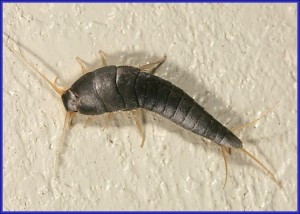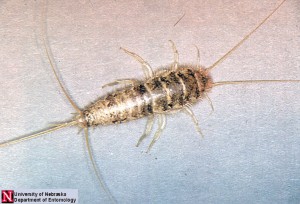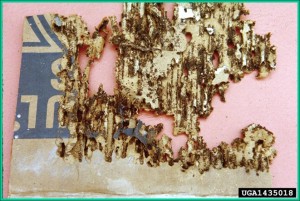
Silverfish and Firebrat
Silverfish (Lepisma saccharina) and Firebrat (Thermobia domestica)
Silverfish (Lepisma saccharina) belong to a very primitive group of wingless insects, known as Thysanura. These insects appeared on earth long before the cockroach. They have a distinctive carrot-like form, long and slender, broader at the front end and gradually tapering to the rear. The silver hair-like scales that cover the body are the basis for its common name. There are three long, posterior filaments that make up the insect’s tail. There are 18 species of Thysanura that occur in North America. Two species are cosmopolitan pests, the common silverfish and the firebrat, Thermobia domestica.
The common silverfish is up to 10mm in length and uniformly silver to slate gray in color. These silverfish are a common pest in homes, libraries and museums where they eat paper, fabrics, and get into cereals. They have mandibles that can remove the sizing of paper in books, and magazines, damaging etchings and prints. They nibble on book bindings and feed on the glue and paste in the binding. This insect prefers cool, damp situations; their preferred temperature range is 72 to 80 degrees F. The common silverfish can live for as long as two years and molt up to 50 times during this period.
If you see silverfish running over the floor, you can be sure there are more specimens lurking behind the walls, in voids of shelving and under baseboards. Silverfish eggs are very small, often laid in cracks and crevices and are carried into buildings along with cardboard boxes and other shipping containers. Silverfish are nocturnal and will quickly retreat into hiding when lights are turned on. In general, silverfish are found at the floor level and on shelving. Moist, dark areas make the most attractive habitats.
There is normally considerable difficulty in eliminating silverfish, most infestations are chronic and seldom are resolved completely. However, in many situations it is possible to tolerate a low level of this pest. If chemicals are the basis of a control program, the accumulation of dead silverfish and their scales over time may create other problems including allergies and a food source for carpet beetles. Under ideal circumstances, it is best to change the environmental conditions that allowed the population to exist in the first place.
The following steps are effective in reducing populations of silverfish over time:
Eliminating moisture in the immediate vicinity of an infestation. Dry out an area and keep it dry. Using desiccants such as silica gel in the microhabitat may accelerate this drying process. Frequently the moist wallboards in new construction projects will introduce silverfish into an area.
Prevent access to food, especially starch containing materials such as paper. Enclose in tightly sealed containers if possible. Another method is to use sticky tape or chalk barrier to prevent silverfish from climbing up the legs of equipment.
The use of heat, especially for the common silverfish, and cold for the firebrat will reduce populations significantly. By maintaining a room at a temperature consistently below 60 degrees F both species of silverfish will be discouraged from breeding.
If environmental conditions cannot be altered, and they are ideal for silverfish development (warm temperature and high moisture with lots of cracks and crevices) then a combination of traps and baits may help reduce populations to acceptable levels.
Sticky survey traps can be set out to capture specimens for verification of species. These traps will also help to locate how pests are entering an area. Traps can also be used to measure the success of control measures.






 Print
Print Email
Email




